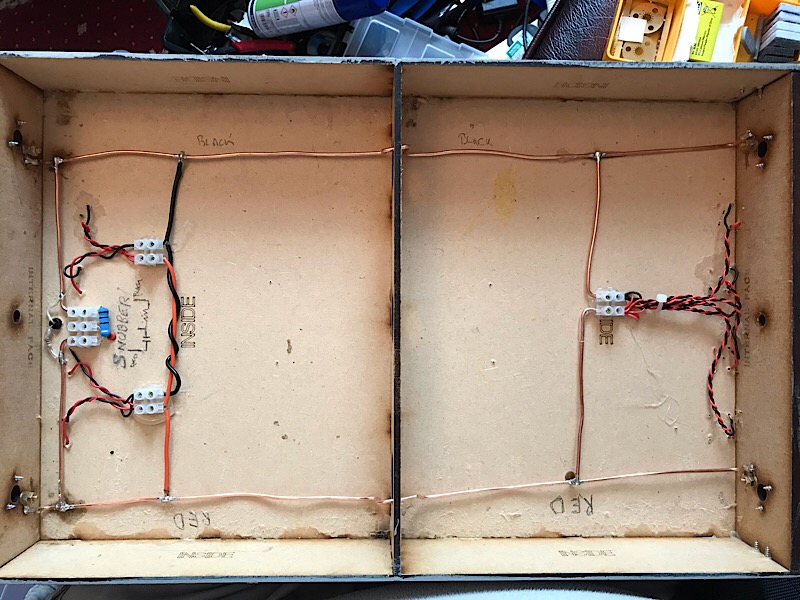
I have now completely rewired the underside of the nine baseboards that comprise Die Keinnamebahn. The following tasks have been completed since our recent RF induced system failure at the Bakewell show.
- All power/DCC buses under the boards have been replaced with 2mm diameter solid copper wire.
- As many track feeds as possible have been replaced with twisted pairs of wires to reduce induced radio frequency pickup.
- All boards now have track feeds at both ends of the tracks on the boards, replacing any centre feeds on sidings etc. which could have produced accidental antennae.
- Resister/Capacitor low-pass filters have been connected across the end of the power/DCC bus wires at both layout ends. They comprise a 100Ω 2 watt resister in series with a 0.1nF 50v capacitor to ‘quench’ or suppress all induced signals above 16.5 kHz. The same filter is also fitted across the layout power feed to prevent the power lead also acting as an aerial. These filters also helps suppress the high voltages that can be induced when a short on the track occurs.
- A ferrite core has been fitted to the input twin core power lead from the SPROG 3 DCC controller to suppress radio frequencies entering the layout through that lead.
- The DCC signals on the tracks have been monitored with an oscilloscope to view the shape of the signals and any distortion induced when a mobile phone is placed on the tracks, none was detected. Neither were any problems found when you touched a rail by induced mains interference, something that was marked on an unprotected length of rail where up to several volts was measured in a domestic environment where ring mains are not earthed and shielded as used in modern commercial buildings.
- I went back to the Bakewell Agricultural Showground with my pocket oscilloscope and a 400mm length of track to measure the interference at the site. TO MY SURPRISE NONE WAS FOUND! Only millivolts of induced voltage was measured. This was totally unexpected as I was certain that it was a mobile phone mast that was the problem. I now have to consider other causes.
It seems that, without the ability at the time to use an oscilloscope, my assumption on the possible source of the interference to the DCC signals on my layout, mobile phone communications, layout may be incorrect
I have therefore, based on this evidence, have to assume that the source of the interference was probably NOT caused by the venue but, more than likely, was caused by some equipment running at the show which was on another visiting layout or stand. Whether this was some radio control equipment or a layout with a DCC system acting as a transmitter I cannot now determine. Whatever the cause it large enough to induce random reprogramming of the DCC chips in several of my locos, including setting a locos max/mid/min speed setting to all zeros and changing several locos speed steps to 14 from the 128 originally set and to distort the DCC signal from my controller enough to make operation impossible.
This episode has taught me that you need to consider the effects of the RF ‘soup’ we now live in when design layouts to exhibit at exhibitions and that building countermeasures in at the design stage is far easier than trying to correct any problems later on.
I can only hope that this will not occur again this coming weekend (6th/7th July) at the North Wales N Gauge show at Conwy when we next display Die Keinnamebahn.
Wish us luck!
